Variety is the spice of life and a charcuterie board is THE ultimate way to keep party appetizers delicious and interesting.
Salumi, cheese, and grapes, OH MY!
Never fear, we’ve got you covered with this step by step guide to making the BEST charcuterie board for any gathering.
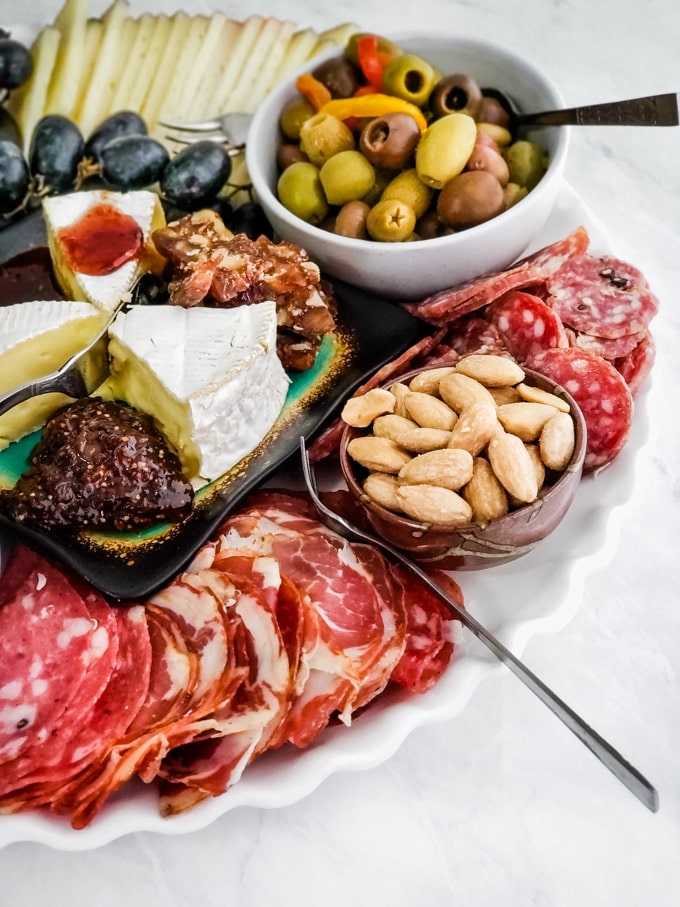
You approach the cheese counter and all of a sudden you’re wondering what raw or rennet might mean, should I buy soft or hard cheese, and wait … there’s goat, cow, and sheep’s cheese?
What’s a washed rind and do you eat that too? Now you’re remembering a bad encounter with a too-funky-stinky-feet blue cheese you had years ago, and suddenly it’s impossible.
Yeah, we cover all those questions and more, but if you have a specific question check this table of contents to skip right to it.
Table of contents
- What is charcuterie?
- Isn’t a charcuterie board just a fancy cheese platter?
- TIPS for building a charcuterie board
- What do I serve charcuterie on?
- Elements of the Best Charcuterie Boards
- Charcuterie Board Accompaniments
- How much should I buy/serve for charcuterie?
- When is the best time to serve charcuterie?
- Arranging a Charcuterie Board STEP BY STEP
- TIPS for Wine Pairings with Charcuterie
- Charcuterie Recipe and Shopping List
- More Recipes for Entertaining You’ll Love
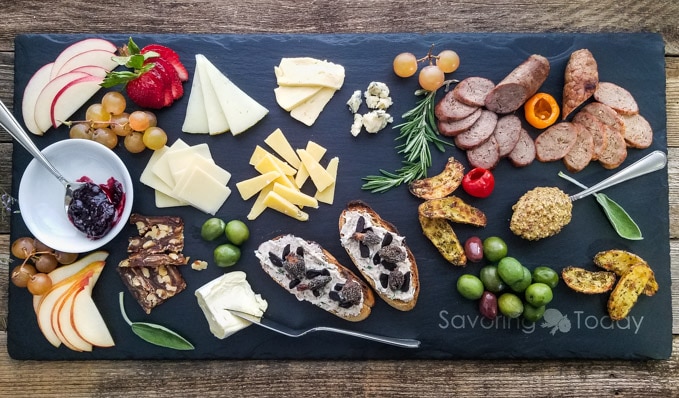
What is charcuterie?
Hearkening from France, the term charcuterie (or Salumi in Italian) traditionally refers to cured meats, specifically different ways to serve as well as preserve before refrigeration was available. Terrine (forcemeat or aspic, similar to pâté), sausage, and salami are just a few.
Charcuterie (shaar·koo·tr·ee) has morphed into a modern appetizer catch-all to include a wide variety of cheeses, dips, fruits, nuts, and crackers spread on trays with a host of different meats for parties and snacking.
Isn’t a charcuterie board just a fancy cheese platter?
Not once in my life have I ever heard someone talk smack on a charcuterie board or call it a fancy cheese platter, and if they did, I’d call their bluff.
Yes, the grocery does have those “party packs” but cheddar, Pepper Jack, and Swiss is a small fraction of the hundreds of thousands of cheeses in the world, many of them made from recipes that are thousands of years old.
Charcuterie is your ticket to explore!
Far beyond the grab-and-go pre-stacked cubed cheese tray, charcuterie is the most varied of all meat and cheese arrangements, the truest mix-and-match, inviting to all levels of appetite and pleasing every palate.
When you present a beautiful board of thoughtfully chosen tastes for your family or guests, your care and efforts are appreciated the moment it’s set on the table.
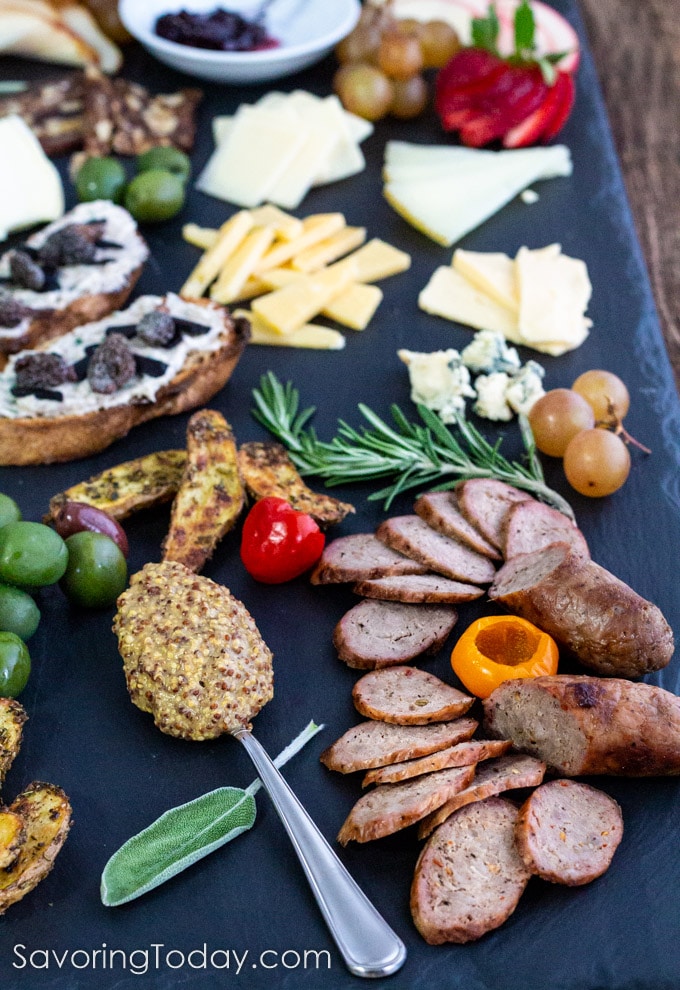
This post may contain affiliate links. See our disclosure policy for more information.
TIPS for building a charcuterie board
- Start small, use our guide, and don’t stress. You can’t mess it up, it’s supposed to be an adventure, so if you’ve never put a board together just follow the step by step.
- Accommodate dietary restrictions with ease. Tailor your board to suit allergies or food sensitivities with careful labeling, separating items (lots of small bowls works just as well as one big board), or avoiding worrisome elements. Gluten-free, vegetarian, paleo, low carb, and lactose-free products are plentiful, though may be easier to find in health food or specialty stores.
- Labeling is helpful but doesn’t have to be complicated. Create your own labels with toothpicks and self-adhesive stickers so you don’t forget or have to say “that’s gouda” a hundred times. I’ve even slipped a sheet of parchment under the ingredients so I could write directly beside each type of cheese with a sharpie. You can also purchase flags and specialty cheese markers.
- Browse thrift stores for cocktail utensils and small bowls, or unique serving boards and platters.
- Check grocery bulk bins for specialty nuts or dried fruits. This is a great way to buy only a small amount of unique varieties.
- Select in-season produce for the best results. There is never a bad time for a charcuterie board because meat and cheese are always in season. Choose in-season fruit for the best color, flavor, and texture (it’s also less expensive.)
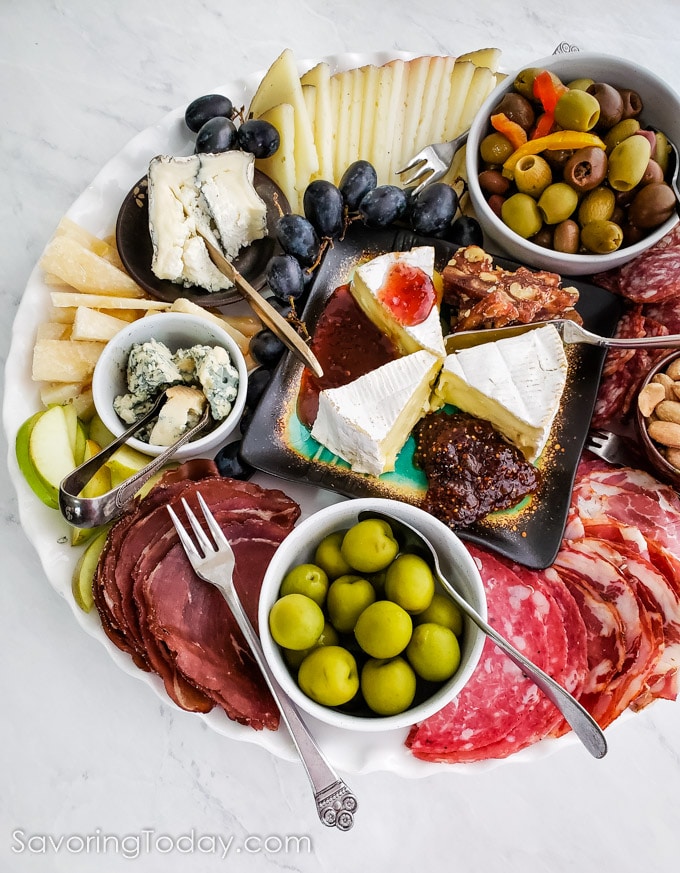
What do I serve charcuterie on?
Is it only on boards? Are there plating rules? There are no rules about what you use to arrange the ingredients. Your dishes don’t have to match, and in fact, your charcuterie board doesn’t have to be on a board.
Let’s review some worthy options for serving charcuterie.
Wood, slate, tile, ceramic platters, and stoneware plates all work beautifully as a backdrop for charcuterie. I’ve used each of these along with an assortment of bowls and ramekins to showcase my collection of goodies. See TIPS for each type below.
Slate, stone, marble boards—all stone slabs will be cool to the touch and provide a gorgeous contrast to the food. Stone is porous which lends to absorbing oils or staining, so take care when placing olives, mustards, or acidic fruits directly on any stone surface. A glossy, polished surface will be most resilient but may show marks when using cutlery or utensils. NOTE: Although slate often comes with soapstone chalk, I haven’t found it very easy to write legibly on a rough surface, so I prefer labeling items with flags. TIP: Stone slabs are good for sliced cheese as the stone stays slightly cooler than room temperature, which is ideal.
Wood boards—warm and rugged, wood offers a naturally homey feel to the presentation, as well as being an actual board. The advantage of using wood cutting boards is they can be less worrisome regarding staining or leaving marks when using cutlery. If you’re the DIY type you can even sand and finish your own creation. TIP: Wood is great for blocks of cheese or sliced cured meats when cutlery is used.
Ceramic, stoneware, and china—the most plentiful and easy to use vessels are what you already have in your cupboard. A mix of plates, platters, saucers, cups, and bowls you use every day might require more individual pieces, but the variety of sizes is more flexible as well as an advantage on smaller tables. Large tiles from home improvement stores or mismatched plates from thrift stores are great options too. TIP: Don’t overlook everyday items like jar lids for spoon rests or short juice glasses for separating cracker types.
If you are partial to having certain serving vessels for certain dishes, you’ll love this charcuterie board, bowls, and utensils kit.
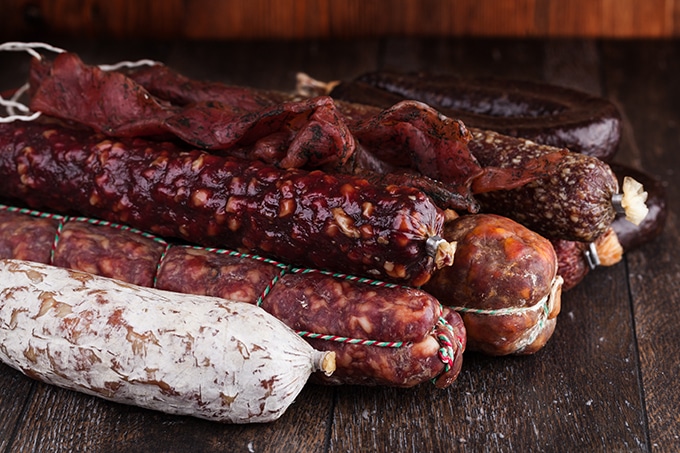
Elements of the Best Charcuterie Boards
Each element brings something special to the board. The very best meals offer a combination of flavor “elements” which are acid (sour), salt, fat (texture), sweet, and umami. The best charcuterie boards incorporate all these elements and strike a balance on the palate.
How to Select Meat for a Charcuterie Board
Cured meats add salinity and savoriness which is a good place to start building your feast.
- Flavor—Consider a mix of savory, salty, smokey, herbaceous, and spicy flavors in a variety of cuts, cures, and countries. Don’t let the fancy Italian and French names scare you off—most local butchers are happy to offer tasting samples with an explanation of each type.
- Meat Type—Select 3 to 5 types of meat in a combination of pork (including wild boar), beef, poultry, lamb, buffalo, and ground mixtures of meats used in pates, terrines, and sausages (even grilled sausages like brats). While fish and shellfish may not be the traditional choices for a charcuterie board, smoked salmon, cocktail shrimp, pickled or fermented fish, and caviar all have a place on your tray if you fancy them.
- Texture—Consider a combination of tender, thinly sliced meats that are easy to roll or layer, hard salami types with a chewy-hearty bite, as well as soft spreadable options like pate.
- Origin—Italy, France, and Spain have been solid producers of artisan cured meats for centuries with classic salamis, saucisson, and chorizo. In recent years, the U.S. has produced cured and encased meats of exceptional quality and flavor worth trying. Because charcuterie has become so popular it is easier to find more options at grocery delis and natural food markets. Our best advice is to include the classics like prosciutto or capicola as well as newly inspired salami infused with fennel pollen, coriander, or rosemary.
- My ideal charcuterie starter combo:
- Whole muscle: Speck (Italian smoked prosciutto)
- Salami: Finocciona salami (Italian salami with fennel)
- Sausage: Chorizo (spicy Spanish pork sausage)
Here’s a simple list of common cured and encased meats, provided by Oberon Wines.
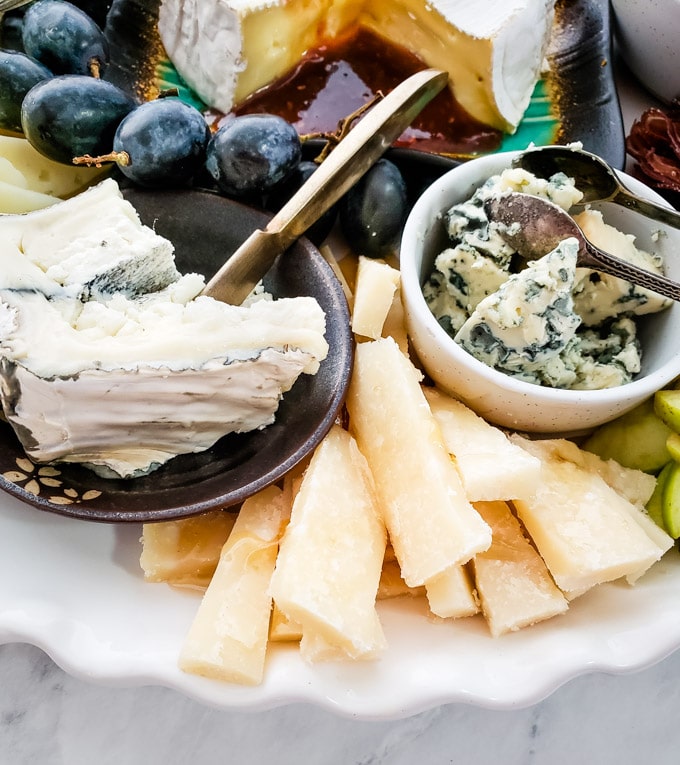
How to Select Cheese for a Charcuterie Board
Cheese brings smooth, creamy textures and rich flavors to complement spicy, savory meats. Cheese is arguably more intimidating (there are just so many!), but it’s rather simple if you approach the selection of cheese in the same way you choose the meat—keep it simple.
To get started, choose 3-6 cheeses, considering a combination of the following:
- Flavor—Consider a mix of savory, nutty, earthy, sharp, tangy, and ripened (funky) flavors from a mix of countries. Don’t let the unfamiliar names scare you off—ask the cheesemonger at the store. A cheesemonger is someone who specializes in selling cheese and if they’re good at it, they also love telling the story of each cheese and offering a sample to try. Let them help you with cheese pairings or recommendations based on your tastes.
- Cheese Milk Type—Choose different milk-types including goat, sheep, and cow, each with its own characteristics influenced by the animal’s diet, cheese production process, and age.
- Texture—Select an array of soft, semi-soft, firm, hard (aged), and blue-veined cheeses.
- Soft cheese varieties are smooth, creamy, and typically spreadable with milder aromas and milky flavors like fresh chevre (goat), buffalo mozzarella, Boursin, Brie, triple cream (Brillat Savarin), Camembert, or Mt. Alice (ripened, soft rind varieties have a stronger flavor). ♥ Pairs well with toasted baguettes, jams, chutneys, aged balsamic, and fresh berries and figs.
- Semi-soft / Semi-firm cheese varieties are usually firm enough to slice, yet slightly spongy and toothsome with subtle earthy or nutty flavors like mozzarella, Port Salut, Gouda (young), Havarti, Monterey Jack, Muenster, Cantal, or Taleggio. ♥ Pairs well with toasted bread, stoneground mustard, onion marmalade, chutneys, pickles, olives, sundried tomatoes, fresh apples, grapes, and berries.
- Firm and hard (aged) cheese varieties are firm enough to slice or grate and aged to increase savory, sharper flavors like Gruyere, Comte, Gouda (aged), Edam, cheddar, Pepper Jack, Manchego, or Parmigiano-Reggiano. ♥ Pairs well with rosemary crackers, sweet-tart apple slices or pear, drizzle of honey, smoked nuts, and Castelvetrano olives.
- Blue-veined cheese varieties are soft yet crumbly, cultured with a blue-green edible mold to bring all the funk you could want. Blues offer savory rich flavors and pungent aromas like Gorgonzola, Roquefort, Stilton, Danish Blue (Danablu), or Bleu d’Auvergne (an especially mild, creamy French blue cheese). ♥ Pairs well with toasted sourdough, fresh figs or pear, dried apricots or cranberries, dates, candied nuts, dark chocolate, and honey.
- My ideal cheese starter combo:
- Soft cheese: Purple Haze (goat lavender and fennel pollen chevre) OR Boursin (garlic & fine herbs)
- Soft Triple Cream: Brillat Savarin triple cream (AMAZING) OR a wheel of Brie with candied pecans, honey, and fresh figs
- Firm: Lamb Chopper (Cypress Grove, sheep’s milk) OR Alp Blossom (Murrays, flower rind, unique!)
- Aged/Hard Cheese: Aged Gouda OR Manchego OR a sharp cheddar (varies from store to store)
- Blue: Bayley Hazen (Jasper Hill, mild blue)
For more cheesy info, check out this easy to navigate Cheese 101 reference guide by Greatist.
Q: Can I eat the cheese rind? Most of the time, yes! Unless covered in wax, paraben, or plastic, most cheese rinds are edible. Here’s a simple guide to edible cheese rinds.
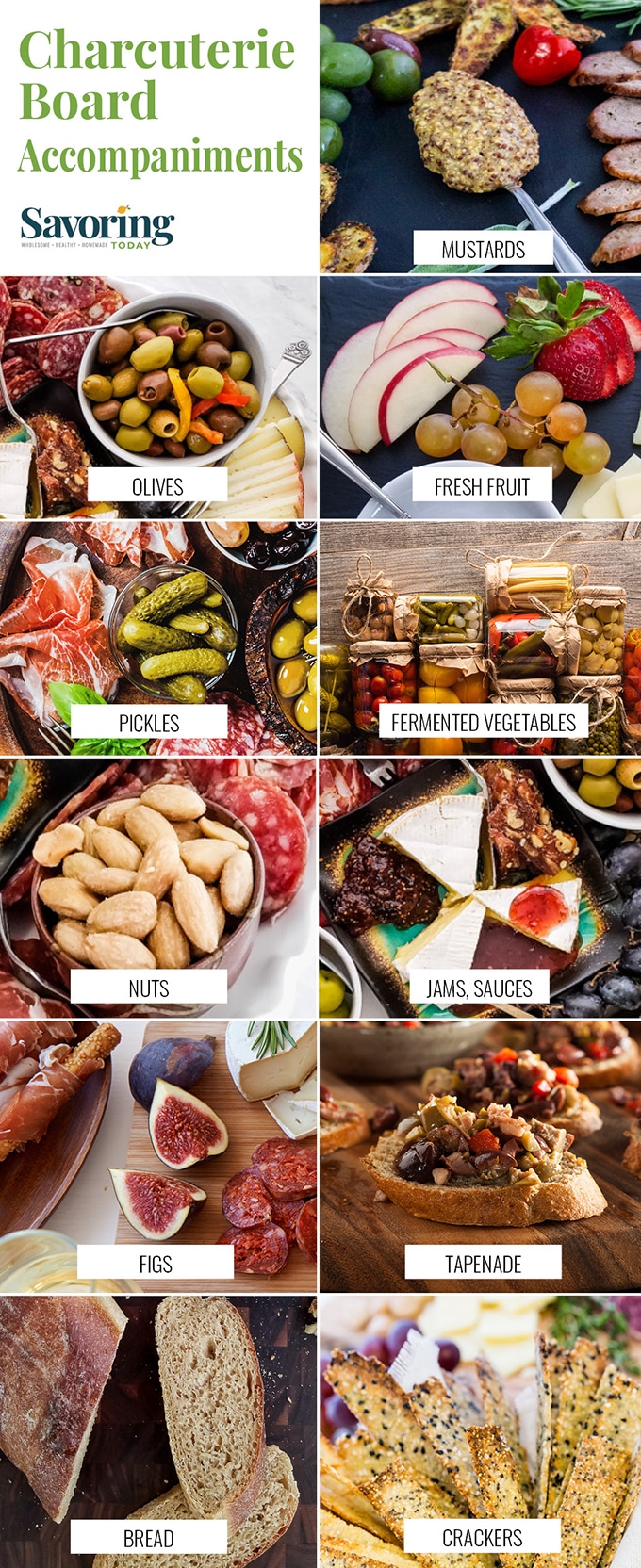
Charcuterie Board Accompaniments
- Bread and Crackers: Consider a soft and crisp option, perhaps a sliced French baguette lightly toasted and a few types of crackers. Cheese straws, golden rounds, Triscuits, pita crackers, water crackers, or rice crackers in their various flavors, like Parmesan, garlic, cheddar, or rosemary (best) provide a plethora of pairing (variety packs are nice too). My ideal trio: sliced baguette, rosemary flat crackers, and butter crackers. TIP: Pair plain water crackers with saltier items like Manchego, while offering saltier butter crackers with less savory cheeses like Brie. French baguette is appropriate for everything.
- Fruit and Vegetables balance the salty and acidic qualities of the meat and creaminess of the cheese with fresh, juicy bites. Create a kaleidoscope of flavor with slices of tart green apple, slightly sweet jicama, pear, crisp snap peas, succulent grapes, melon, pomegranate, summer-fresh berries, bright tangerine, ripe floral figs, and refreshing cucumber.
- Pickles and Ferments enliven each flavor profile with bright, sour notes to cleanse and refresh your palate for each bite. Get creative with tart-buttery olives, sweet gherkins, dilly green beans, gingery carrots, pickled red onions, artichokes, or green strawberries to reap delicious rewards. TIP: Add a citrus surprise to your olives—mix in a few strips of fresh orange peel (without the white pith) and let sit for a few hours.
- Jams, Chutneys, Balsamic, and Spreads are the loving harmony to all, enhancing subtle flavors or lending moisture to a dry bite of toast. Whole grain Dijon, spicy brown, horseradish, and honey mustard are all excellent with meats, especially sausage and salami. Like fresh fruit, jams, chutney, and preserves bring concentrated sweetness complementing the more salty items on the board. Aged balsamic is an exceptional garnish for soft cheeses, adding bright, tangy, umami to whatever it touches. TIP: Place a spot of honey near the blue cheese and a dollop of jam near the Brie or goat cheese—feel free to serve it directly on the plate if you don’t have a small ramekin or condiment cup.
- Nuts and Dried Fruit are the small bits of crunch or chewy sweetness to follow a perfect bite. Dried apricot, dates, fig, candied ginger, candied walnuts or pecans, smoked almonds or warmed Marcona almonds are like nuggets of hidden treasure when spread around to garnish the board.
- My ideal accompaniments starter combo:
- Bread and crackers: Butter crackers and La Panzanella Croccantini Rosemary Crackers
- Fruit and vegetables: black seedless grapes, tangerine segments, sliced Fuji or Honeycrisp apple, sliced jicama, quartered figs (when in season)
- Pickles and ferments: Castelvatrano olives (light green, plump, not as salty as most olives, more buttery and mellow), pickled green beans, dill pickles
- Jams, dips, spreads: a dollop of homemade dijon mustard, blackberry, fig, or apricot jam (or both!)
- Nuts and dried fruit: Marcona almonds (Spanish almonds with a rich flavor)
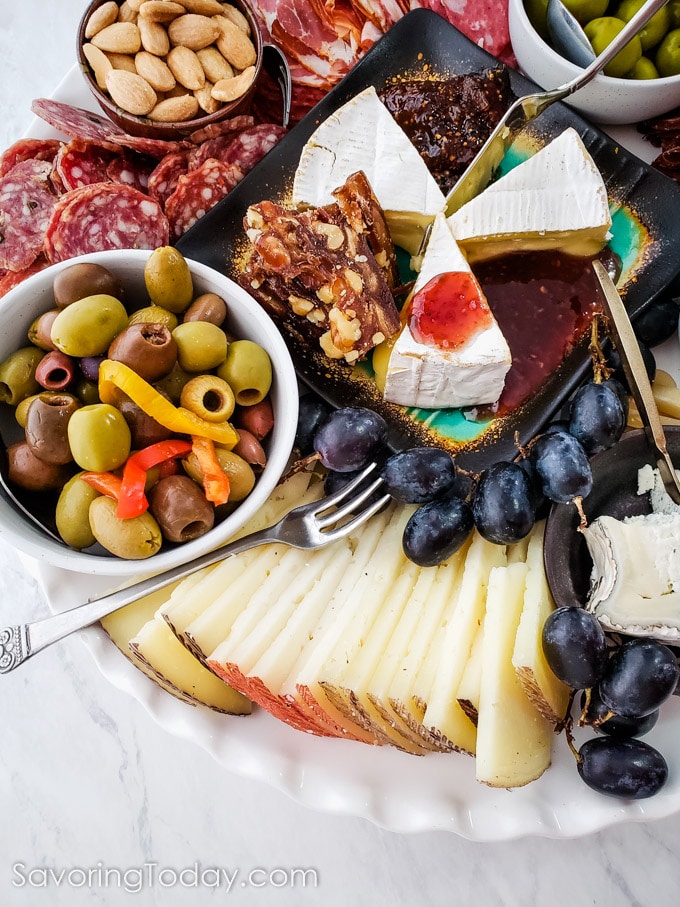
How much should I buy/serve for charcuterie?
- 3 ounces of meat and 3 ounces of cheeses per person; you aren’t buying 3oz of EACH cheese/meat, only a total sum of 3 & 3 per guest, planning for each person to snack on a variety of items you place on the board.
TIP: Don’t forget to check if the store has a cheese sample bin with smaller wedges, which may be a more economical way to select a wider variety. - Fruits and vegetables should match the amount of meat and cheese in board real estate—if the meat and cheese cover 12 inches of the board or plate, then fruit and vegetables should cover approximately that same amount of space.
- Pickles, olives, nuts, and jams get tucked in and around the platter to encourage guests to mix and match these accompaniments with everything on the board.
- Ultimately you will buy some items in larger quantities than you’ll use creating a single board like a whole bag of grapes, jars of olives, or boxes of crackers, so leftovers are inevitable. TIP: Leftover fruit can be frozen for tossing in breakfast smoothies!

When is the best time to serve charcuterie?
Charcuterie is best served anytime, anywhere! The portion sizes and variety might change, but the concept of offering choice meat and cheese with fresh accouterments is timeless. To serve your board as an appetizer, follow the detailed recipe below.
Otherwise, here are some ideas for enjoying a tray for breakfast, lunch, or even dinner.
Ideas for serving charcuterie for breakfast or light lunch
- Select only one or two types of meat and cheese.
- Serve with toasted baguette, fresh melon or berries, poached egg (optional), pickles, and jam.
- Serve with arugula greens dressed with balsamic and olive oil dotted with candied nuts.
Ideas for serving charcuterie as a main meal
- Serve one or two hot dishes like meatballs, stuffed mushrooms, steamed mussels, crab legs, shrimp scampi, roasted fingerling potatoes, Brussels sprouts, artichoke dip, or tomato and basil bruschetta with the charcuterie board to create a complete dinner.
- Serve small-bite desserts like Cheesecake Strawberries with Chocolate Accents or Double Chocolate Truffles
How long should a charcuterie board sit at room temperature?
Perishable foods should not sit out for longer than 2 hours (if food is exposed to temperatures above 90°F, like a hot car or summer picnic, refrigerate it within 1 hour). While most cheese can be returned to the refrigerator, according to USDairy.com, soft-ripened cheeses like Brie, Camembert, and fresh mozzarella should be discarded.
TIP: When re-wrapping to refrigerate, wrap the cheese in waxed or parchment paper, and then in plastic wrap to balance air and moisture for best storage results.
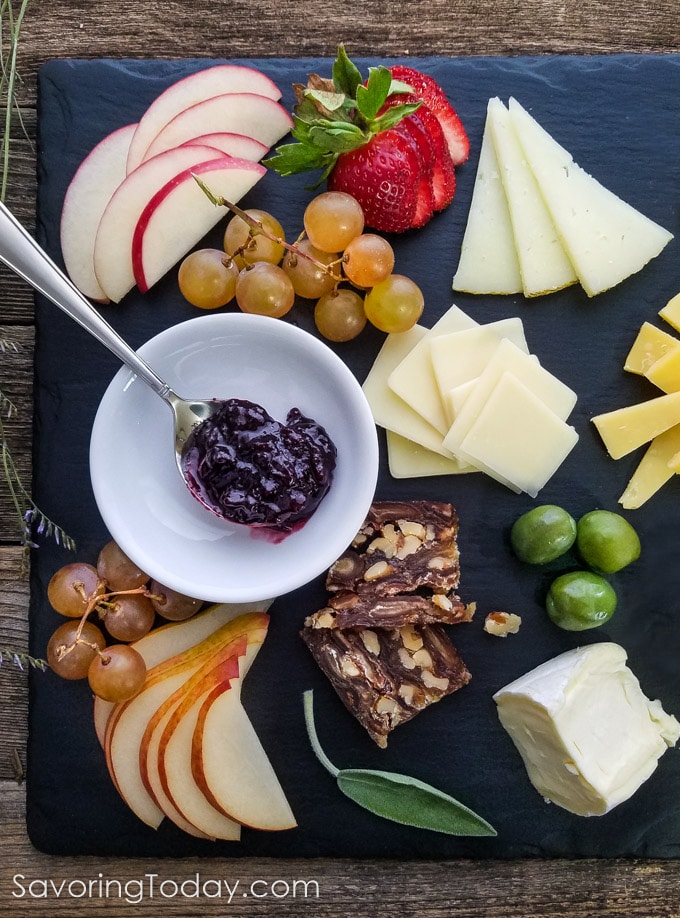
Arranging a Charcuterie Board STEP BY STEP
For this recipe, we’ll assume you’re serving 6 people (the number of servings can be adjusted in the recipe card below).
- Pre-slice, cube, or quarter each item to arrange for quick and easy serving. It might look cool to serve a wedge of cheese with a cute knife, but expecting guests to slice their own cheese on the board is cumbersome and requires too much work for party going.
- Meat and cheese should be thinly sliced, 1/8-inch or so. TIP: Slice cheese in advance and refrigerate until 30 minutes before guests arrive; cheese should be cool, but not cold.
- Fresh fruit sliced to about 1/4-inch, though I prefer to quarter figs. TIP: Prepare fruit closer to the time of serving and squirt lemon juice on apples and pears to prevent browning.
- Berries, nuts, olives, and grapes remain whole. TIP: Remove fruit spreads and olives from the refrigerator an hour before serving to bring to room temperature for enhanced flavor.
- Soft cheeses, pate, and rillettes should be served with a small knife. (We love this classic charcuterie knife set and this fun stainless steel set too.)
- Select your serving board. It’s fine to just use a cutting board or plates. For this, I generally use one board with a few bowls or plates as needed.
- Start by arranging the meats: For example, separate the individual pieces or slices of speck, salami, and chorizo sausage so they’re not stuck together. I usually make small rolled “roses” or tube rolls of thinly sliced meats like speck or prosciutto and spread a long stack of chorizo sausage like a deck of cards. Arrange the meat in 3 separate places on the board for the best composition, though some folks like to put them all together, which is perfectly fine.
- Arrange the cheeses alongside the meats to mirror the three-point composition. They are usually light/white in color and look beautiful next to the reds and browns of the meats. Any whole chunks of hard/semisoft cheeses like gouda and cheddar are in thin slices with each slice slightly offset, like a spread-out deck of cards. For soft cheeses like Boursin, ricotta, or goat cheese I like to serve about 4 ounces directly on the board with a small knife for serving/spreading. NOTE: If you’re serving brie and want it warm, it is best placed on a separate (oven-safe) plate for warming/melting purposes and also to dress it. We like to put honey, candied pecans, and figs over and around the brie.
- Add the fruit and vegetables close to the cheese if the board is large enough. However, rather than overcrowd the board, it is perfectly fine to arrange the bulk of the fresh items on a separate tray or plate and simply dot the board with a few clusters of grapes.
- Tuck in the mustards, jams, or dips. Use small condiment cups or lay the whole spoon-full-of-mustard or jam on the board beside the items they pair with best. (A small dollop of honey right beside the blue cheese is always a hit!) I typically put the sweet dips next to the cheeses and the mustard near the meats since they tend to pair together, but they also pair well in reverse! Have a few extra serving spoons/knives available to limit cross-contamination.
- Scatter pickles, olives, and nuts throughout the board or contain them in separate small bowls if they’re prone to roll around too much. Springs of rosemary are also a nice addition for garnish.
- Place the bread or crackers in a separate bowl or basket to keep the board neat and tidy. (I don’t like crumbs on the board and don’t want the crackers to get soggy if they get pushed into some jam or wet olives.) Of course, if there is plenty of room left on the board you can stack a few crackers beside the meat and cheese.
- Position the board in the center of your serving area with any additional bowls of crackers or olives nested close to it. Additional small spoons, spreaders, and cocktail forks are always handy alongside the plates and napkins for serving. Now, pour some wine and dig in.
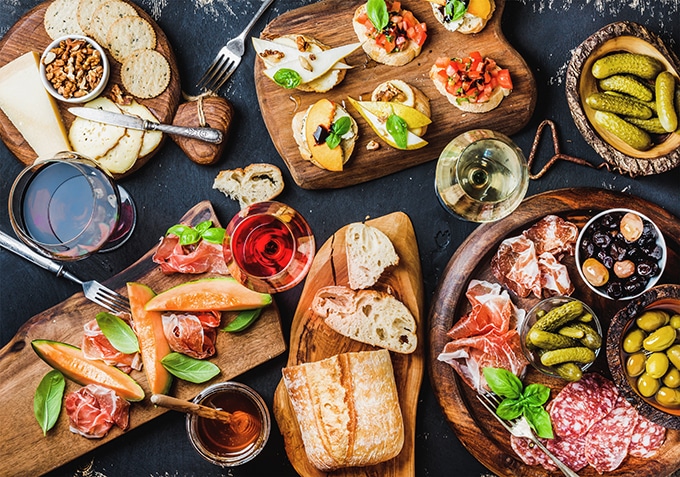
TIPS for Wine Pairings with Charcuterie
Wine is meant to accompany and highlight the food before you. Most charcutiers and cheesemongers publish detailed profiles of their products, commonly sharing other food and wine pairings alongside the descriptions of the items. A quick search of the purveyor or simply the style of the product will reveal clues for solid wine pairings.
Here is my go-to wine pairing
- Pinot Noir from the Pacific Northwest
- Italian table wine like a Sangiovese Chianti Classico
- Pinot Grigio
- Dry German or Austrian Riesling (not the typical sweeter wines) TIP: Go to your local wine shop (I mean one that is mostly devoted to wine, not just a liquor store) and ask them for a dry riesling recommendation—you will not be disappointed. Riesling is a top choice for its ability to have high acid content, fresh minerality, and bright fruit character with an unparalleled clean finish. It’s my favorite wine to pair with rich, delicious foods like charcuterie.
I highly recommend having both red and white wine present as they offer different emphasis and flavors. I don’t recommend bold cabernet sauvignon or oaky chardonnay simply because it may tire out your palate and there are already big flavors on the board. This is not a rule, however, if you like bold big wines, by all means, drink what you like! The pairing police won’t come for you.
Get MORE TIPS from our article about Hosting a Wine and Cheese Party.
Charcuterie Recipe and Shopping List
We’ve provided a specific recipe for 6 (below) as well as a Printable Charcuterie Board Shopping List for general reference if you simply want a guide with all the options.
Charcuterie Board Recipe
Ingredients
- 6 oz Speck
- 6 oz Finocciona salami sliced
- 6 oz Chorizo sliced
- 3 oz Purple Haze goat chevre with lavender & fennel pollen served with knife for spreading
- 3 oz Brillat Savarin triple cream served with knife for spreading
- 3 oz Lamb Chopper Cypress Grove sheepsmilk cheese sliced
- 3 oz aged gouda sliced
- 3 oz Bayley Hazen (Jasper Hill, mild blue)
- 5 oz Castelvatrano olives
- 12 oz pickled green beans
- 5 oz Marcona almonds
- 1/2 pound black seedless grapes trimmed into 4-5 grape clusters
- 2 tangerines peeled and separated into segments, or clementines
- 1 oz Dijon mustard , or stoneground mustard
- 1 large Fuji apple or honeycrisp
- 5 fresh figs quartered, or Medjool dates, or fresh pear
- 6 oz jicama sliced, or radish, or cucumber
- 2 oz blackberry or apricot jam (or both!)
- 1 package butter crackers
- 1 package La Panzanella Croccantini Rosemary Crackers
Instructions
Slice and Dice
- Pre-slice, cube, or quarter so each item is arranged for quick and easy serving. It might look cool to serve a wedge of cheese with a cute knife, but expecting guests to slice their own cheese on the board is cumbersome and requires too much work for party going.
- Meat and cheese should be thinly sliced, 1/8-inch or so. TIP: Slice cheese in advance and refrigerate until 30 minutes before guests arrive; cheese should be cool, but not cold.
- Fresh fruit sliced to about 1/4-inch, though I prefer to quarter figs. TIP: Prepare fruit closer to the time of serving and squirt lemon juice on apples and pears to prevent browning.
- Berries, nuts, olives, and grapes remain whole. TIP: Remove fruit spreads and olives from the refrigerator an hour before serving to bring to room temperature for enhanced flavor.
- Soft cheeses, pate, and rillettes should be served with a small knife. (We love this classic charcuterie knife set and this fun stainless steel set too.)
Select a Large Board or Platter
- Select your serving board, platter, plate, or an assortment of plates and bowls. It's fine to just use a cutting board or plates. For this, I generally use one board with a few bowls or plates as needed.
Meats
- Start by arranging the meats: For example, separate the individual pieces or slices of speck, salami, and chorizo sausage so they’re not stuck together. I usually make small rolled “roses” or tube rolls of thinly sliced meats like speck or prosciutto and spread a long stack of chorizo sausage like a deck of cards. Arrange the meat in 3 separate places on the board for the best composition, though some folks like to put them all together, which is perfectly fine.
Cheese
- Arrange the cheeses alongside the meats to mirror the three-point composition. They are usually light/white in color and look beautiful next to the reds and browns of the meats. Any whole chunks of hard/semisoft cheeses like gouda and cheddar are in thin slices with each slice slightly offset, like a spread-out deck of cards. For soft cheeses like Boursin, ricotta, or goat cheese I like to serve about 4 ounces directly on the board with a small knife for serving/spreading. NOTE: If you’re serving brie and want it warm, it is best placed on a separate (oven-safe) plate for warming/melting purposes and also to dress it. We like to put honey, candied pecans, and figs over and around the brie.
Fresh Fruits & Vegetables
- Add the fruit and vegetables close to the cheese if the board is large enough. However, rather than overcrowd the board, it is perfectly fine to arrange the bulk of the fresh items on a separate tray or plate and simply dot the board with a few clusters of grapes.
Mustards, Jams, Chutneys
- Tuck in the mustards, jams, or dips. Use small condiment cups or lay the whole spoon-full-of-mustard or jam on the board beside the items they pair with best. (A small dollop of honey right beside the blue cheese is always a hit!) I typically put the sweet dips next to the cheeses and the mustard near the meats since they tend to pair together, but they also pair well in reverse! Have a few extra serving spoons/knives available to limit cross-contamination.
Pickles, Olives, Nuts, Dried Fruits
- Scatter pickles, olives, and nuts throughout the board or contain them in separate small bowls if they’re prone to roll around too much. Springs of rosemary are also a nice addition for garnish.
Bread, Crackers, Crisps
- Place the bread or crackers in a separate bowl or basket to keep the board neat and tidy. (I don’t like crumbs on the board and don’t want the crackers to get soggy if they get pushed into some jam or wet olives.) Of course, if there is plenty of room left on the board you can stack a few crackers beside the meat and cheese.
- Position the board in the center of your serving area with any additional bowls of crackers or olives nested close to it. Additional small spoons, spreaders, and cocktail forks are always handy alongside the plates and napkins for serving. Now, pour some wine and dig in.
Notes
- Slice cheese in advance and refrigerate until 30 minutes before guests arrive; cheese should be cool, but not cold.
- Prepare fruit closer to the time of serving and squirt lemon juice on apples and pears to prevent browning.
- Remove fruit spreads and olives from the refrigerator an hour before serving to bring to room temperature for enhanced flavor.
Nutrition
If you were wondering, yes, I am absolutely an unabashed nerd about arranging charcuterie boards and revel in the way it ushers one through a journey of flavors and textures.
More than an appetizer or party platter, charcuterie can be an entire meal! For people who need food variety and like to graze like me, it’s absolutely my favorite way to eat.
More Recipes for Entertaining You’ll Love
- 45 Bridal Shower Menu Ideas
- Scampi-Style Steak and Scallops Date Night Dinner
- How to Make An Amazing Crab Leg Dinner at Home
- Entertaining & Hospitality ~ Performing vs. Serving: A Hospitality Series
- 7 Tips for Hosting a Wine & Cheese Party
- Thanksgiving Dinner: 7 Tips for Hosting, Prepping, & Menu Basics
- Valentine’s Day Dessert Ideas: 10 Sweet Treats to WOW Your Sweetheart
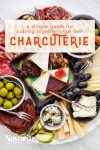
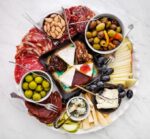
John / Kitchen Riffs says
What an awesome post! Tons of info and tips in this — really good job. Thanks so much! And Happy New Year!
mjskitchen says
What fun!!! We love putting these together but always have a hard time deciding what we want. Love your tutorial and ideas. Lots of new choices to consider. Thanks Judy!